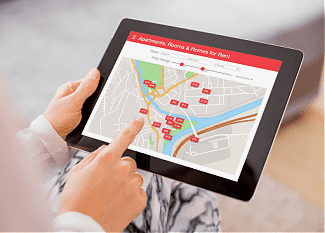Raising the Bar on the Apartment Search with Visual, Personalized Experiences

Modern consumers have a need for speed. Think Amazon: Customers shopping online can research, review, evaluate and make purchases within a matter of minutes.
The online shopping experience has set a new standard of customer expectation; shopping must be intuitive, efficient and personalized. With more renters searching online for their next apartment homes, that expectation remains the same for multifamily. Apartment operators are trying to catch up with warp-speed consumer needs by optimizing the apartment search and expediting the buying process.
Renters crave personalized content, flexibility with touring, consistent communication and transparency in the apartment search, which typically happens across multiple platforms. More and more operators have started offering self-service options while centralizing leasing to create a more streamlined approach to renting apartments. But there are still some pieces missing from the apartment search journey in order to meet modern consumers where they’re at.
Selecting a new home, whether it’s renting an apartment or buying a house, is an immensely personal decision and also a visual experience. Renters want the context of the overall community and the exact apartment they’d rent, which is provided online with photos, videos, virtual tours, maps and 3D floor plans. Without this context, renters will be reluctant to sign a lease.
“We strongly believe in the need to provide a rich, digital companion that complements our physical assets,” said Mike Gomes, chief experience officer at Cortland, which owns and manages more than 80,000 apartment homes. “Living in an apartment is a physical experience. The apartment search needs a more comprehensive digital representation that provides the necessary visual context around that physical experience that renters desire to make confident decisions.”
Here’s how apartment communities and Internet Listing Services (ILSs) are augmenting content delivery with visual context and providing modern renters what they want for increased conversions and customer satisfaction.
It’s all about context in apartment search
It’s time to bid farewell to marketing “similar” apartments.
Renters don’t want similar – they want to select their own apartment and have the ability to choose it from any platform, whether it’s from the community website or an ILS. Location is an amenity, and renters want to choose where they will live. In order to do that, they need to understand community layout and where specific apartments are located within the community.
“When it comes to the apartment-shopping experience, renters need the ability to do their own research and understand the living experience, even without visiting the physical location,” Gomes said. “An interactive, digital overlay allows renters to get answers to their questions and best understand where available apartment homes reside within the context of the broader apartment community. Consumers want to do their own research, and that digital representation of the community streamlines not only the shopping process, but decision making.”

A recent Apartments.com survey found that 82 percent of renters reported that seeing the location of their apartment on a property was extremely or very important to their search.
“There is an inherent shift in renter preferences and our clients have noticed that renters are spending more time engaging with maps than even some of the apartment images and videos,” said Brent Steiner, founder and CEO at Engrain. “The data indicates that renters really care about the apartment location, the actual views and features, plus proximity to parking or amenities within a community, which are all driving their decisions. It’s information they want even before stepping foot on the property.”
According to data from Apartments.com, user engagement on listings with maps is significantly higher than listings without maps. Incoming leads are also more specific and pertain to an individual apartment. ILS listings have always included apartment photos and floor plans, but that content doesn’t provide location, community context, nor imagery of the actual apartment.
“Renters want to narrow their search to a very specific selection of apartment homes that are tailored to their individual needs and desires,” said Jaclyn Hosking, senior marketing manager at Bozzuto, which manages more than 87,000 apartment homes. “Key visual content like photos, videos and interactive maps, integrated at the very beginning of the apartment search, delivers the hyper-personalized shopping experience that consumers expect.”
Bozzuto’s page-view data varies drastically from community to community, depending on factors such as website design, unit availability and emphasis on the floor-plan experience vs. defaulting to Engrain’s SightMap view. The data notably shows that SightMap consistently delivers more pageviews on mobile devices. Bozzuto also found its customers spend about 10 times more time on SightMap than the conventional floor plans. Renters are not only drawn to the maps, but they’re also spending a substantial amount of time looking at and engaging with them.
“Nearly 40 percent of our residents move to a Cortland community from outside the market they’re in,” Gomes said. “They’re making these big decisions using as many online resources as possible, and we need to supply the content, information, and visual tools necessary for them to make these decisions with confidence.”
Website content drives hyper-personalization
Nearly every part of the online experience is defined by hyper-personalized content. Targeted ads, product recommendations and content algorithms make sure consumers are seeing the things they’re most interested in and likely to engage with.
According to a survey from customer data platform Twilio Segment, more than half of respondents said personalization improves the buying experience, and 60 percent said they would become repeat buyers after a personalized experience.
No matter the industry, marketing teams across the world have started developing larger budgets for personalized content. And personalization is crucial when it comes to communicating with renters about an apartment, one of the most personal decisions they’ll make.
Free Rental Application
Get 20 Rental Forms for FREE, including a rental application.
Prospective residents’ online behavior, notably the content they’re spending the most time looking at, combined with CRM information ultimately drives the ability to provide hyper-personalized follow ups and offer a more enjoyable experience. Artificial intelligence (AI) and automation tools are tracking this information while seamlessly moving prospects through the funnel and sending information that is unique to each individual renter.
“Our Journey AI tracks every aspect of a lead and we start with behavior on the website and combine it with events and preferences from the CRM,” said Robert Lee, COO at Hyly.AI. “With this information, our AI can determine the right message based on where they are in the journey and identify the right time to send it based on past behavior.”
Community websites that display interactive maps not only provide a visually rich and enjoyable search experience for prospects but the maps also provide vital information when it comes to follow ups. Maps help AI and automation tools identify prospect preferences and eliminate the guessing game for leasing teams about which units to show.
“Multifamily has started shifting to providing more resident-centric experiences, and a large part of executing that is looking beyond all the ways customers engage with your brand,” Gomes said. “When we understand the myriad ways customers want to engage, we can begin to create more transparent, seamless, and memorable apartment-shopping experiences that help renters gain a more complete picture of life in a community.”
Tracking every digital interaction of the customer journey is essential in modern leasing. There is a direct correlation between residents who spend more time engaging with a website and lease conversion.
“We have visibility into the time and page depth of someone on a community website who leases, and found a higher lease-conversion rate for prospects who engaged longer on the website,” Lee said. “On average, properties with an interactive map get an immediate lift in time spent on the website. It is incredible how engaged prospects get when exploring the unit map.”
Renter preferences will continue to evolve, and multifamily must keep pace. Right now, renters expect visual, hyper-personalized experiences. These experiences meet customers where they’re at and fuel their buying decisions. By incorporating these elements into community websites and ILS listings, operators raise the bar on the apartment search, cast a wider net for prospective residents and increase long-term satisfaction.
Source: Rental Housing Journal















 Accessibility
Accessibility